|
||||||||||
|
|
||||||||||
|
||||||||||
|
|
||||||||||
Bombings aboard commercial airliners are unfortunately nothing new. These attacks have plagued airline travel almost since its beginning. While most of the early bombings were suicide attempts or schemes for insurance money, terrorism became a dominant motive for increasingly deadly attacks since the 1960s. The following list describes 88 cases related to airliner bombings, 56 of them resulting in deaths.
10 October 1933 - United Airlines
A Boeing 247 airliner flying from Cleveland to Chicago exploded in mid-air over Chesterton, Indiana. Ten people
(7 passengers, 3 crew) were killed in the crash, and the cause was determined to be a nitroglycerin bomb. No
suspects or motive were ever found.
7 May 1949 - Philippine Air Lines
A flight from Daet to Manila carrying 13 people (10 passengers, 3 crew) disappeared over the Sibuyan Sea. The
Douglas DC-3 crashed, killing all aboard, after suffering a violent explosion in its tail. Two ex-convicts later
confessed to planting a time bomb on the aircraft. The plot was intended to kill a male passenger so his wife
could marry another man she was involved with.
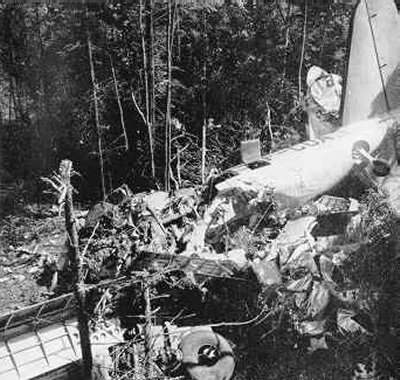
9 September 1949 - Canadian Pacific Airlines Flight 108
A Canadian Pacific Douglas DC-3 left Montréal for a suburb of Quebec City. The plane was then to continue on to
Baie-Comeau. Shortly after takeoff on the second leg of the journey, however, the aircraft disintegrated killing
all 23 aboard (19 passengers, 4 crew). The disaster was caused by a dynamite bomb placed in the forward baggage
compartment by Albert Guay. His wife, Rita Morel, had boarded the plane at Quebec City. The marriage was troubled
and Guay had taken a mistress. Since divorce laws in Quebec were very strict at the time, Guay plotted to kill his
wife and collect $15,000 in life insurance. Guay assembled the bomb with help from Généreux Ruest, a clockmaker
who constructed the timing mechanism. Another accomplice was Ruest's sister, Marguerite Pitre, who air expressed
the device on the DC-3. All three conspirators were hanged for the crime.
13 April 1950 - British European Airways
A Vickers Viking operated by BEA was over the English Channel on a flight from Northolt, England, to Paris when a
bomb exploded in the aft lavatory. Though the blast created a hole
12 August 1952 - Transportes Aéreos Nacionales
A Douglas DC-3 operated by the Brazilian airline TAN left Rio Verde headed for Goiania with 24 people aboard
(20 passengers, 4 crew). The aircraft never reached its destination after suffering a mid-air explosion caused by
a bomb.
11 April 1955 - Air India
A Lockheed L-749 airliner called the Kashmir Princess was on a charter flight from Bombay, India, to Hong Kong to
Jakarta, Indonesia. The Air India plane carried 19 people including delegates from China and Vietnam as well as
several journalists from Asia and Europe bound for the Asia-Afro Bandung Conference. About five hours after
departing Hong Kong while flying over the Natuna Islands, an explosion started a fire behind the inboard engine on
the right wing. Smoke quickly spread through the cabin and cockpit as the aircraft lost pressure. While
attempting to ditch at sea, the right wing struck the water and the plane broke apart. Three members of the crew
escaped and were rescued but the other 16 aboard were killed. Investigators concluded the explosion was caused by
a bomb most likely planted to assassinate the premier of China, Zhou Enlai, who was to be on the flight. Zhou
cancelled at the last minute, and there is evidence he may have known about the plot in advance. Kuomintang agents
from Taiwan were believed responsible for the bombing and investigators suspected the explosive was placed by Chow
Tse-ming, a janitor with Hong Kong Aircraft Engineering Company who had access to the plane. Chow fled to Taiwan
whose government refused to extradite him while also denying he was a Kuomintang operative. Evidence also suggests
the American CIA played a role in the assassination attempt and may have provided the bomb.
1 November 1955 - United Airlines Flight 629
United 629 was a Douglas DC-6B en route from Denver to Portland, Oregon. Nine minutes after takeoff, the aircraft
was destroyed by a bomb composed of 25 sticks of dynamite. The explosive detonated in the number 4 baggage
compartment causing the plane's tail to disintegrate and sending it out of control. All 44 passengers and crew
were killed in the crash. A man named Jack Graham was arrested for the act. Graham's mother, Daisie King, was on
the plane and he hoped to claim $37,500 of life insurance policies he had bought from vending machines at the
airport just before departure. Ironically, the life insurance policies were invalid since his mother had not
signed them. Graham apparently had a long grudge against his mother as well as a criminal history. He was
arrested for forgery in 1951 and had also collected insurance on one of his mother's restaurants that mysteriously
exploded. Graham was put to death in the gas chamber a year after the bombing.

25 July 1957 - Western Air Lines Flight 39
Western 39 was a multi-stage flight on a route from Minneapolis to Salt Lake City to Cedar City to Las Vegas to
Los Angeles. A passenger named Saul Binstock flew from Burbank, California, to Las Vegas and never left the
airport terminal prior to boarding the Western Air Lines flight back to Los Angeles. The Convair CV-240 had just
taken off carrying 16 people (13 passengers, 3 crew) when Binstock locked himself in the aft lavatory and set off
a dynamite bomb. Though he was killed and the blast created a
17 April 1959 - Tigres Voladores
Flying between the Mexican cities of Mexicale and Guaymas, a Curtiss C-46 carrying 26 people (21 passengers, 5
crew) crashed near Puerto Kino. The plane had exploded and caught fire in mid-air, and it is believed a bomb was
the cause.
8 September 1959 - Mexicana
A Douglas DC-3 carrying 16 people (13 passengers, 3 crew) took off from Mexico City bound for Merida, Mexico.
A detonation in the passenger cabin started a fire and forced an emergency landing at Poza Rica. A male passenger
was suspected of carrying a bomb aboard, and he was the only fatality after he was blown from the plane at an
altitude of 11,000 ft (3,350 m).
16 November 1959 - National Airlines Flight 967
A Douglas DC-7B carrying 42 people (36 passengers, 6 crew) was en route from Tampa, Florida, to New Orleans when it
crashed into the Gulf of Mexico. The investigation took a bizarre turn when a mystery was uncovered involving
passenger William Taylor. Taylor disappeared the day before the flight after telephoning his employer that he
would be late for work. He next turned up at the airport just before National 967 departed and purchased a $37,500
flight insurance policy. Though it appears Taylor was killed on the flight and his ex-wife received the insurance
money, the peculiar fact is the airline had no record of anyone by that name being aboard. The ticket Taylor used
was instead issued to Robert Spears. Spears lived in Texas but was in Tampa visiting his friend Taylor at the time
of the crash. The two men knew each other well and both had long criminal backgrounds. Spears is suspected of
tricking Taylor into taking the flight and carrying a piece of luggage with a bomb inside. When the plane was
destroyed killing all aboard, it would be assumed Spears had perished and his wife could collect $100,000 in life
insurance. Spears vanished after the crash until he was arrested in Phoenix, Arizona, for unlawful possession of
Taylor's automobile. Despite finding dynamite and blasting caps in the vehicle, investigators were unable to
conclusively link Spears to the plane's loss. The lack of physical evidence made sabotage impossible to prove and
no charges were ever brought.
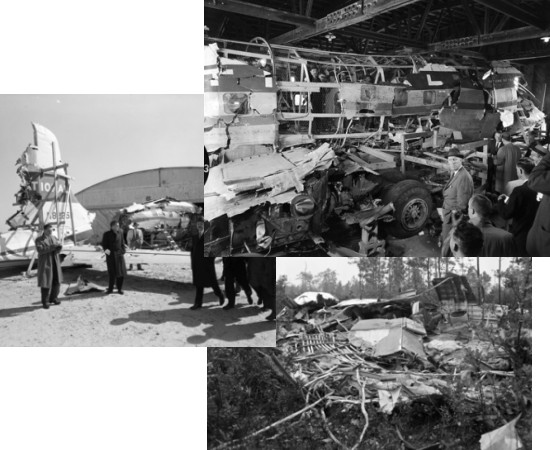
6 January 1960 - National Airlines Flight 2511
A Douglas DC-6B flying from New York City to Miami disintegrated in mid-air and crashed in North Carolina, killing
all 34 aboard (29 passengers, 5 crew). The aircraft crashed due to the detonation of a dynamite bomb in the
vicinity of row 7. It is believed a passenger named Julian Frank committed suicide when he set off the bomb in his
lap or under his seat. Frank was under investigation for fraud and embezzlement and had purchased life insurance
policies worth $1 million before the crash. Given the similarities to the National 967 crash two months earlier,
however, others suspect Frank may have been innocent and was unaware he was carrying a bomb. No one was charged in
either case and the two crashes remain mysterious to this day.
10 May 1961 - Air France Flight 406
A Lockheed 1649A Starliner operated by Air France was carrying 78 people (69 passengers, 9 crew) on a flight from
Brazzaville, Congo, to Paris. During a leg from Chad to Marseilles, the aircraft crashed into the Sahara Desert in
Libya killing all aboard. The cause of the crash was traced to a nitrocellulose bomb that detonated in flight.
22 May 1962 - Continental Airlines Flight 11
The first commercial jet flight to be sabotaged was Continental 11 en route from Chicago to Kansas City to Los
Angeles. The Boeing 707 carried 45 people (37 passengers, 8 crew) when
a dynamite bomb hidden in a towel container under the washbasin in the right rear lavatory detonated. The blast
caused the plane's tail to break away and the aircraft went out of control, crashing near Unionville, Missouri, and
taking the lives of everyone aboard. Responsibility was blamed on a passenger named Thomas Doty who had a criminal
record and purchased $300,000 in life insurance shortly before the flight.
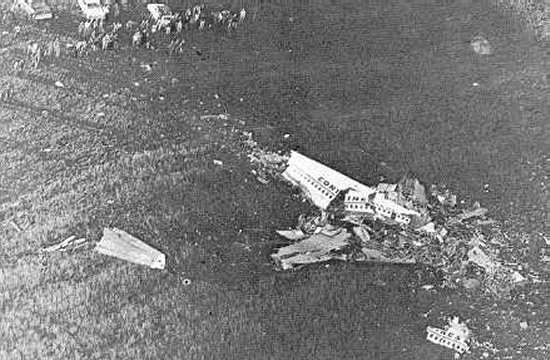
8 December 1964 - Aerolineas Abaroa
A Douglas DC-3 was carrying 17 people (13 passengers, 4 crew) between the Bolivian cities of Tipuani and La Paz
when the plane crashed in the Andes Mountains. The impact resulted from a bomb blast in the aft passenger cabin
that blew off the plane's tail. It is believed a passenger used the bomb to commit suicide for insurance money,
and no one survived.
8 July 1965 - Canadian Pacific Airlines Flight 21
Canadian Pacific 21 departed Vancouver for Whitehorse. The Douglas DC-6B crashed in British Columbia after the
plane's tail section broke away from the rest of the fuselage. Investigators suspect a passenger mixed acid and
gunpowder in the aft lavatory setting off an explosion. The crash killed all 52 aboard (46 passengers, 6 crew).
The motive for the bombing is believed to be a suicide-for-insurance scheme.
22 November 1966 - Aden Airways
All 30 passengers and crew aboard a Douglas DC-3 were killed when the aircraft crashed at Aden, Yemen. An
in-flight bomb detonation was determined to be the cause.
9 May 1967 - Cubana de Aviación
A Cubana flight from Havana to Mexico City crashed shortly before landing. All 10 people (6 passengers, 4 crew)
aboard the Antonov An-12 were killed in the impact that was blamed on a bomb blast.
12 October 1967 - British European Airways Flight 284
BEA CY284 was a de Havilland Comet 4 that departed Athens, Greece,
bound for Cyprus. While flying at 29,000 ft (8,840 m), a bomb located under seat 4A or 5A in the rear of the
tourist cabin detonated. The aircraft descended as the pilots struggled to maintain control, but the plane began
breaking up at 15,000 ft (4,570 m) and crashed into the Mediterranean Sea. All 66 people (59 passengers, 7 crew)
aboard were killed. It is believed the bomb was placed by terrorists hoping to kill the general in command of the
Cyprus army who was to be aboard but cancelled shortly before departure.
11 December 1967 - American Airlines
An American Airlines Boeing 727 had departed Chicago when a small
explosion occurred one hour and 42 minutes after takeoff. The blast was caused by a crude homemade bomb located in
the aft baggage hold. None of the 78 passengers and crew were injured and the plane landed safely.
19 November 1968 - Continental Airlines
A Boeing 707 carrying 70 people was preparing to land at Denver when an
explosion occurred in one of the lavatories. Though the blast started a small fire, the pilots were able to make
an emergency landing with no injuries. A passenger seen leaving the lavatory just before the explosion was
arrested by the FBI.
26 December 1968 - El Al Flight 253
El Al 253 was a Boeing 707 flying from Tel Aviv, Israel, to New York.
During a layover in Athens, two terrorists from the Popular Front for the Liberation of Palestine fired a
submachine gun and threw grenades at the plane while it was on the runway prior to takeoff. The attack killed one
passenger and seriously injured a crew member before the two assailants were captured by Greek police.
11 March 1969 - Ethiopian Airlines
While sitting on the ground at Frankfurt, West Germany, with no one aboard, two explosions in the passenger cabin
rocked a Boeing 707 doing considerable damage.
22 December 1969 - Air Vietnam
During final approach at Nha Trang, Vietnam, a bomb exploded aboard a Douglas DC-6B blasting a 5 ft (1.5 m) hole
in the fuselage near the port cabin washroom. The plane's hydraulic system failed so the landing gear had to be
lowered manually and the flaps would not deploy. As the stricken plane touched down, it overran the end of the
runway striking several houses and a school. The impact killed 10 of the 77 people aboard as well as 24 victims on
the ground.
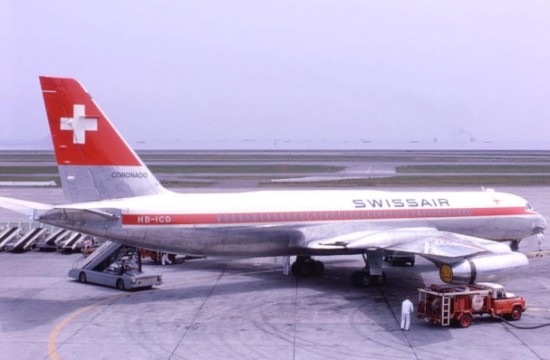
21 February 1970 - Swissair Flight 330
Swissair SR330 left Zürich, Switzerland, for Tel Aviv, Israel, carrying 47 people (38 passengers, 9 crew). The
Convair CV-990 suffered an explosion about nine minutes after takeoff due to a bomb triggered by change in
atmospheric pressure carried in the aft cargo hold. As the crew attempted to turn back towards the airport for an
emergency landing, smoke clouded the cockpit and electrical power was lost. The aircraft crashed shortly
thereafter with no survivors. The militant group Popular Front for the Liberation of Palestine claimed
responsibility for the bombing.
21 February 1970 - Austrian Airlines
On the same day as the Swissair attack, the Popular Front for the Liberation of Palestine detonated a second bomb
aboard an Austrian Airlines Caravelle airliner traveling from Frankfurt, Germany, to Vienna. The bomb, located
inside a mailbag due to be carried to Israel on a later flight, exploded about 20 minutes after takeoff. Though a
6 ft² (0.6 m²) hole was torn in the bottom of the fuselage, the aircraft landed safely at Frankfurt and none of the
38 people (33 passengers, 5 crew) aboard were injured.
21 April 1970 - Philippine Air Lines
A Hawker Siddeley HS-748 crashed near Manila, Philippines, after a bomb exploded in the aft cargo hold. The crash
killed all 36 passengers and crew.
24 August 1971 - Alia Jordanian Airlines
An empty Boeing 707 was parked at Madrid, Spain, when a bomb in an aft
lavatory exploded. The blast tore a 3 ft (1 m) long hole in the top of the fuselage but no one was harmed.
21 November 1971 - China Airlines
A Caravelle III airliner operated by the Taiwan carrier China Airlines was on a flight from Taipei to Hong Kong
when the plane mysteriously vanished. The jet crashed into the sea off the coast of Penghu Island killing all
25 passengers and crew. Though never proven, a bomb is considered the most probable cause of the crash.
26 January 1972 - JAT Yugoslav Airlines Flight JU 367
JU 367 departed Stockholm, Sweden, for Belgrade, Yugoslavia, carrying 23 passengers and 5 crew. While flying over
Czechoslovakia, the Douglas DC-9 suffered a blast in the forward cargo
hold. The resulting explosive decompression ripped the plane apart. The cause was a homemade bomb believed to
have been planted by a Croatian extremist group called Ustasji. Although the bombing killed 27 people, a 22 year
old flight attendant named Vesna Vulovic miraculously survived. Vulovic fell some 33,330 ft (10,150 m) while
strapped to a section of the plane that cushioned her impact. Though she had broken both legs, was temporarily
paralyzed from the waist down, and took 27 days to come out of a coma, she eventually recovered from her injuries
after 16 months of treatment.
Since this article was originally written, new evidence has brought the circumstances of this case into question. Outside observers had long questioned the speed with which investigators determined an extremist bomb was responsible for the crash even though no one took responsibility for the act and no arrests were ever made. Others noted the debris field was too small for a plane disintegrating at high altitude. In 2009, a pair of investigative journalists published new information suggesting JU 367 was accidentally shot down by a Czech fighter and broke up at an altitude closer to 2,600 ft (800 m). The authors contend the DC-9 was attacked after being mistaken for a threat to a nearby plane containing Soviet leader Leonid Brezhnev who had just left a conference in Prague. Because of her injuries, survivor Vesna Vulovic has no memory of the flight, and the story of a terrorist bombing and her miraculous survival was reportedly created to cover up the incident.
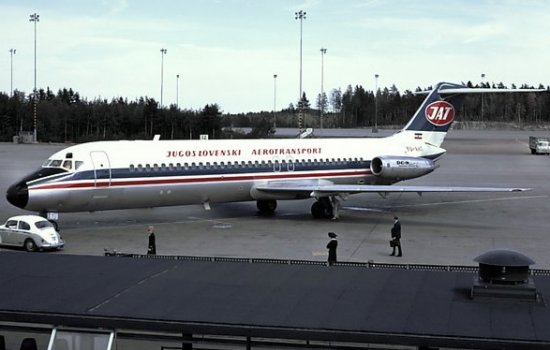
7 March 1972 - Trans World Airlines Flight 7
Following labor disputes at TWA, an extortion plot against the airline was organized by an unknown person calling
himself Gomez. Gomez warned that four bombs had been planted aboard TWA aircraft and would go off over an 18-hour
period, but he would provide the bomb's locations if paid $2 million. He said the first was aboard TWA Flight 7, a
Boeing 707 that had just departed New York for Los Angeles with 52
people aboard. The aircraft quickly returned to the airport and a bomb containing 5 lb of C4 explosive was
discovered in a briefcase in the cockpit. The device would have exploded midflight and was diffused by police just
12 minutes before detonation.
8 March 1972 - Trans World Airlines Flight 57
The extortion plot against TWA continued when a bomb exploded aboard a
Boeing 707 that was parked at Las Vegas, Nevada, with no one aboard.
The plane had arrived from New York seven hours earlier and was searched before departure, in flight, and after
arrival. Even though under guard, someone managed to sneak a C4 bomb into the aft portion of the cockpit or the
forward lavatory. The 707 was so badly damaged by the blast that it had to be written off. TWA apparently never
paid the $2 million ransom, but a company private plane possibly carrying the money flew from New York to Atlanta
and returned four hours later after the extortionists failed to arrive for a meeting. A spokesman for the airline
subsequently reported Gomez had not been heard from again.
Additional explosives, probably planted by copycat bombers, were also found on two United planes before they were set to go off. Dynamite was discovered aboard a flight into Seattle and plastique explosives were found concealed in two spray cans on a Boeing 727.
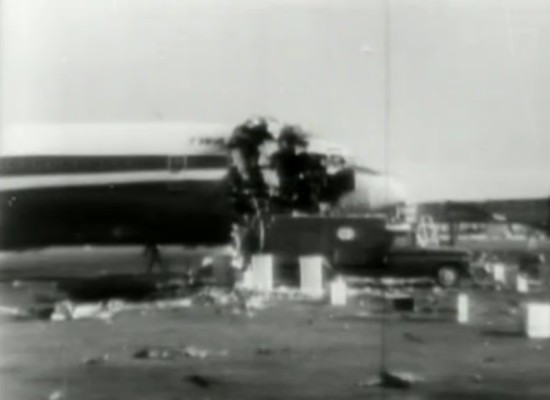
25 May 1972 - LAN Chile
A LAN Chile flight from Panama City, Panama, to Miami suffered an explosion about one hour and 18 minutes after
takeoff. The Boeing 727 was carrying 50 people (40 passengers, 10
crew). The blast was caused by a crude pipe bomb planted in the ice water fountain service compartment. Though
the plane experienced a rapid decompression, no one was harmed and the pilots made an emergency landing at Montego
Bay, Jamaica.
15 June 1972 - Cathay Pacific Airways Flight 700Z
A total of 81 people (71 passengers, 10 crew) were killed when Cathay Pacific CX700Z crashed in Vietnam. The
Convair CV-880 had departed Bangkok for Singapore and on to Hong Kong. During the second leg of the journey, an
explosive device hidden in a suitcase under a seat on the right side of the cabin detonated. A Thai police officer
was accused of planting the bomb to kill his daughter and her fiancé, but he was acquitted due to lack of evidence.
16 August 1972 - El Al Israel Airlines
A Boeing 707 of Israel's El Al had just taken off from Rome bound for
Tel Aviv when a bomb hidden in a portable record player exploded in the aft baggage compartment. The airline had
adopted reinforced cargo containers that reduced the bomb's effectiveness. Though the 200 grams of explosive blew
a hole through the baggage hold, the aircraft landed safely at Rome and none of the 148 people aboard were injured.
8 December 1972 - Ethiopian Airlines Flight 708
Ethiopian Flight 708 was a Boeing 720 carrying 94 passengers and crew. About 13 minutes after takoff from Addis
Ababa, seven hijackers from the Eritrean Liberation Front pulled out guns and tried to take control of the plane.
The attempt was thwarted by six armed security guards. As the two sides traded gun fire, one of the terrorists
activated a gand grenade. A passenger grabbed the live explosive and lobbed it into the aft fuselage since this
portion of the cabin was unoccupied. The grenade detonated, damaged both the inboard engine and rudder controls,
and filled the cabin with smoke. Nevertheless, the pilots were able to return to the airport for an emergency
landing. Six of the terrorists were killed aboard the plane and the seventh died later in a hospital. The other
87 aboard survived, and the plane was repaired and returned to service.
19 March 1973 - Vietnam Airlines
All 62 passengers and crew aboard a Douglas C-54D were killed when a bomb exploded in the plane's forward cargo
hold. The aircraft crashed at Ben Me Thuot, South Vietnam.
21 April 1973 - Philippine Air Lines
A Hawker Siddeley HS-748 carrying 33 people crashed near Patabangan, Philippines, after a bomb exploded aboard.
18 May 1973 - Aeroflot
An Aeroflot flight from Moscow to Chita in Siberia was hijacked with 100 passengers and crew aboard. When the
hijacker's demands were not met, he set off a bomb in the passenger cabin. The
Tu-104A broke up at 30,000 ft (9,145 m) and crashed near Chita with no
survivors.
17 December 1973 - Pan American World Airways Flight 110
Pan Am 110 was a Boeing 707 preparing to leave Rome for Beirut with 177
people aboard. Departure was delayed when a group of Palestinian gunmen stormed through the terminal and across
the tarmac towards the aircraft. The men threw two phosphorous bombs onto the plane killing 30 and injuring 41
passengers. The attackers went on to take five hostages, kill a customs agent, and hijack a Lufthansa
Boeing 737. The plane flew to Damascus and then Kuwait before one of
the hostages was killed and the terrorists escaped. The hijackers were eventually arrested and convicted, and the
attack was traced to Abu Nidal's Fatah group.
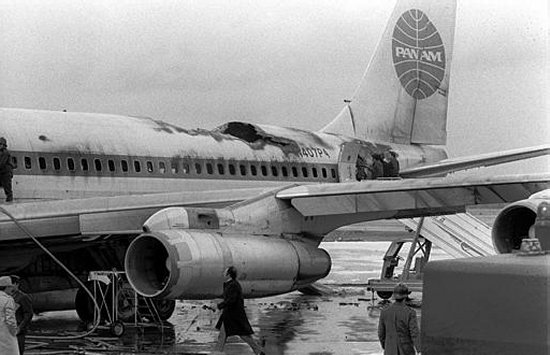
22 March 1974 - Air Inter
A Caravelle III airliner on the ground at Bastia, France, was heavily damaged when an explosion occurred in the
forward landing gear compartment. No one was injured.
26 August 1974 - Trans World Airlines
Shortly after landing in Rome, a fire broke out in the aft baggage compartment of a TWA flight. The fire was
caused by a bomb that had malfunctioned. No one was injured. The failed bombing may have led to the attack on TWA
841 the following month.
8 September 1974 - Trans World Airlines Flight 841
TWA 841 was a Boeing 707 that left Tel Aviv, Israel, for New York
City. The flight made a scheduled stopover in Athens before heading on its second leg to Rome. Just 18 minutes
after takeoff, however, the plane crashed into the Ionian Sea killing 88 people (79 passengers, 9 crew).
Subsequent investigation concluded the plane was brought down by a bomb hidden in the aft cargo hold that resulted
in structural failure. A group in Lebanon claimed responsibility for the bombing, and the Abu Nidal terrorist
organization is believed to have been behind the attack.
15 September 1974 - Air Vietnam Flight 706
Air Vietnam 706 was a Boeing 727 carrying 75 people (67 passengers, 8
crew) between the South Vietnam cities of Danang and Saigon. The plane was hijacked by a soldier named Le Duc Tan
who was distraught over a recent demotion. The hijacker threatened the crew with two hand grenades and demanded
the plane divert to Hanoi, North Vietnam. The pilots instead tried landing at the Phan Rang Air Base but aborted
shortly before the plane plunged into the ground killing all aboard. Investigators believe the hijacker was
angered by the landing attempt, forced the abort, and then set off his grenades resulting in the fatal crash.
3 June 1975 - Philippine Air Lines
A BAC One-Eleven departed Legaspi carrying 64 people (59 passengers, 5 crew) bound for Manila. As the plane
descended for landing, a bomb detonated in the right lavatory in the aft passenger cabin. The blast created a
large hole
5 July 1975 - Pakistan International Airlines
A Boeing 707 was on the ground in Rawalpindi, Pakistan, following a
flight from Karachi. After the passengers had disembarked, a bomb exploded under a seat in the cabin ripping a
1 January 1976 - Middle East Airlines Flight 438
MEA 438 was a Boeing 720 en route from Beirut to Dubai. While flying over northeastern Saudi Arabia at 37,000 ft
(11,275 m), a bomb detonated in the forward baggage hold. The plane broke up and the crash killed all 81 people
aboard. The identity of the bombers has never been determined.
2 July 1976 - Eastern Airlines
An unoccupied Eastern Airlines L-188 Electra parked at Boston Logan Airport was destroyed by a bomb planted in the
landing gear compartment. No one was injured.
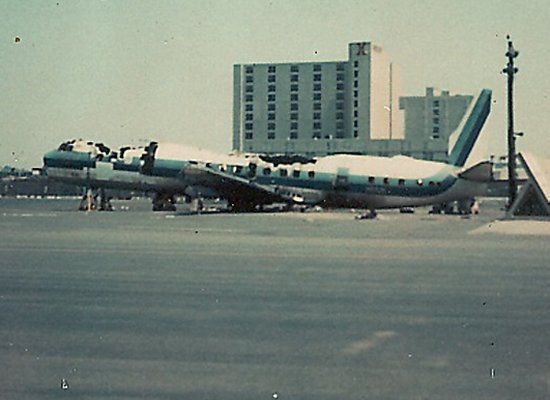
7 September 1976 - Air France
Seven masked men planted dynamite explosives aboard a Boeing 707 parked
at Ajaccio, France. No one was injured in the subsequent blast but the plane was destroyed.
6 October 1976 - Cubana de Aviación Flight 455
Cubana 455 was headed from Barbados, via Trinidad, to Havana. The Douglas
DC-8 carrying 73 people (48 passengers, 25 crew) exploded and spun downward crashing off the coast of
Bridgetown, Barbados. The aircraft is believed to have been destroyed by two time bombs using dynamite or C-4
explosives that set off an uncontrollable fire in the aft cabin. The plot was traced to anti-Castro Cuban exiles
and Venezuelan secret police who reportedly had links to the Central Intelligence Agency in the United States.
17 August 1978 - Philippine Air Lines
With 84 aboard (78 passengers, 6 crew), a BAC One-Eleven left Cebu for Manilla. One passenger was killed when a
bomb blast in the left rear lavatory blew a hole in the fuselage. The aircraft landed safely with no additional
injuries. Like a cat with nine lives, the plane involved was the same PAL airliner that survived a bombing in June
1975.
19 February 1979 - Ethiopian Airlines
A Douglas DC-3 crashed at Barentu, Ethiopia, after a bomb exploded on board. All five passengers and crew were
killed.
26 April 1979 - Indian Airlines
An Indian Airlines flight from Trivandrum was descending to land at Madras (now Chennai) when an explosion went
off in the forward lavatory. The detonation caused a complete instrument and electrical failure aboard the
Boeing 737. The plane was forced to make a high speed landing because
the flaps could not be extended. With thrust reversers and anti-skid systems also disabled, the aircraft overran
the end of the runway. Though the right side of the plane caught fire, all 67 occupants (61 passengers, 6 crew)
evacuated safely. All survived but the 737 was written off due to the damage.
15 November 1979 - American Airlines Flight 444
American 444 was a Boeing 727 carrying 78 people (72 passengers, 6
crew) and headed from Chicago to Washington DC. Thirty minutes into flight, a mail bomb hidden in a wooden box in
the cargo hold ignited. The device produced large amounts of smoke but failed to detonate, though investigators
found only a faulty timer prevented the bomb from obliterating the plane. The pilot made a successful emergency
landing at Washington-Dulles but several passengers had to be treated for smoke inhalation. The bomb was built by
Ted Kaczynski, better known as the Unabomber, and this was his first attack to be investigated by the FBI.
Kaczynski's bombing attempts spread over 18 years before he was finally caught in 1996, and he has since been
sentenced to life imprisonment.
9 September 1980 - United Airlines
Passengers were disembarking a Boeing 727 in Sacramento, California,
when a small cardboard box in the cargo hold detonated. The explosion injured two cargo handlers but none of the
44 passengers and crew were harmed.
21 December 1980 - Transportes Aereos del Caribe
A Caravelle of TAC left Rio Hacha, Colombia, on its first scheduled flight following 17 months of maintenance.
The flight was bound for Medellín with 70 people aboard (63 passengers, 7 crew). Five minutes after takeoff, an
explosion set off a fire on the right side of the tail causing the plane to lose control and crash. A bomb is
suspected, but not proven, to have caused the crash.
31 August 1981 - Middle East Airlines
No one remained aboard a Boeing 720 that had arrived in Beirut, Lebanon, following a flight from Tripoli, Libya,
when a large bomb exploded. The 5000 grams of dynamite destroyed the plane.
13 October 1981 - Air Malta
A Boeing 737 was being unloaded at Cairo, Egypt, following a flight
from Malta when a porter and three security guards were injured by bomb blasts. Two explosive devices hidden in
parcels exploded about 15 minutes apart. A third bomb was located later but did not detonate. None of the
passengers and crew were harmed.
12 December 1981 - Aeronica
A Boeing 727 of the Nicaraguan airline Aeronica was about to board for
a flight from Mexico City to San Salvador, El Salvador. As passengers were preparing to embark, a bomb hidden
between the cabin wall and the furthest aft passenger seat on the left aisle exploded. The blast injured the
captain, two stewardesses, and an airport mechanic. The plane was also seriously damaged with a 3 ft (0.9 m) hole
torn in the fuselage.
11 August 1982 - Pan American World Airways Flight 830
A Boeing 747 of Pan Am was on a flight from Tokyo to Honolulu, Hawaii,
when a bomb hidden under a seat cushion detonated. The explosion killed a 16 year old Japanese boy, injured 15
more passengers, tore a hole in the floor, and also damaged the cabin ceiling and overhead luggage bins. Despite
the damage, the aircraft made a safe emergency landing at Honolulu with no further injuries. A terrorist named
Mohammed Rashed who belonged to the 15 May group, an offshoot of the Popular Front for the Liberation of Palestine,
was blamed for the attack. Rashed was finally arrested in Greece in 1988 and sentenced to 15 years in prison. He
was released in 1996 after serving only eight years, but the United States convicted Rashed for another seven year
sentence in 2006.
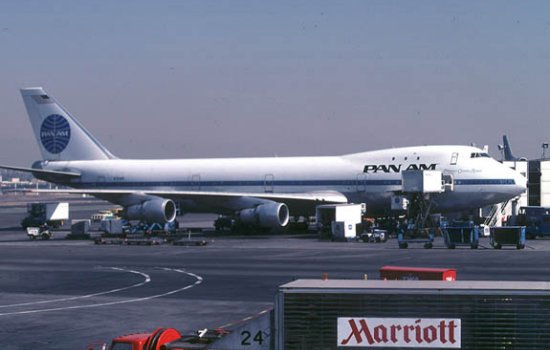
19 August 1983 - Syrian Arab Airlines
While boarding passengers at Rome for a flight to Damascus, Syria, a fire started aboard a
Boeing 727. The blaze was set off by a glass bottle containing
flammable liquid that had been placed under a seat near the right overwing emergency exit. The fire consumed the
interior of the plane doing considerable damage, but no one was hurt.
23 September 1983 - Gulf Air Flight 771
Gulf Air 771 left Abu Dhabi, United Arab Emirates, for Karachi, Pakistan, aboard a
Boeing 737 carrying 117 people (111 passengers, 6 crew). The aircraft
exploded shortly after takeoff and crashed in the desert near Mina Jebel Ali in the UAE. A bomb in the baggage
compartment caused the fatal crash. The terrorist Abu Nidal took responsibility demanding that nations in the
region pay him protection money to avoid future attacks. Both the UAE and Kuwait paid Nidal off shortly thereafter.
18 January 1984 - Air France
An Air France Boeing 747 was carrying 261 passengers and crew when
an explosion rocked the aircraft shortly after leaving Karachi, Pakistan. The blast created a hole in the right
aft cargo compartment causing rapid decompression. The pilots made an emergency descent and landed at the airport
with no injuries.
10 March 1984 - Union des Transportes Aériens
A Douglas DC-8 was traveling from Brazzaville, Congo, to Paris. While
the aircraft was parked on the apron during a stopover in N'Djamena, Chad, a small explosive device went off in the
baggage compartment. The 23 people (18 passengers, 5 crew) aboard at the time were evacuated without injury.
Twenty minutes later, a second bomb detonated in the central baggage hold destroying the aircraft.
23 January 1985 - Lloyd Aèreo Boliviano
The LAB flight left La Paz, Mexico, for Santa Cruz, Bolivia. While en route with 127 occupants (120 passengers,
7 crew), a passenger entered the forward lavatory carrying a suitcase. Inside the suitcase was dynamite that
exploded, killing the passenger. The Boeing 727 landed safely at
Santa Cruz with no additional fatalities.
9 March 1985 - Royal Jordanian Airlines
A Lockheed L-1011 TriStar was on the ground at Dubai following a flight from Karachi, Pakistan, when a bomb
exploded in one of the baggage holds. No one was harmed in the blast.
23 June 1985 - Air India Flight 182
The deadliest terror attack of any kind prior to September 11 was Air India 182, a flight from Montréal to London
to Delhi to Bombay. The Boeing 747 carried a total of 329 (307
passengers, 22 crew) when it disappeared over the Atlantic Ocean south of Ireland. A bomb located in the forward
cargo hold had detonated at an altitude of 31,000 feet (9,500 m) causing rapid decompression and break-up of the
plane. A second bomb was also to be transferred aboard Air India Flight 301, scheduled to carry 177 passengers
from Tokyo to Bangkok. However, this bomb exploded at the Tokyo airport killing two baggage handlers and injuring
four others. The attacks were blamed on a Sikh separatist group called Babbar Khalsa, but only one person was
convicted for the attack after almost 20 years of investigation and prosecution by Canadian authorities. Bomber
Inderjit Singh Reyat had his prison term reduced to just five years in exchange for testimony against other alleged
plotters, but he was later sentenced to another nine years for perjury.

30 October 1985 - American Airlines
A bomb hidden in a vinyl tote bag exploded aboard a Boeing 727. The
blast occurred in the forward baggage hold while being unloaded and there were no fatalities.
2 April 1986 - Trans World Airlines Flight 840
A Boeing 727 preparing to land at Athens, Greece, was badly damaged by
a bomb explosion. The device consisted of 1 lb of plastic explosive placed under a seat cushion. The detonation
blew a 24 ft² (2.25 m²) hole in the fuselage resulting in a rapid decompression of the cabin that sucked four
people out to their deaths, including an infant. Another five people suffered injuries but 110 passengers and crew
survived when the plane landed safely. A Lebanese woman was suspected of planting the bomb during a previous
flight. She was arrested and believed to work for the Abu Nidal organization, but the woman was not convicted for
lack of evidence. A group called the Arab Revolutionary Cells claimed responsibility for the attack in retaliation
for America's involvement in the Israeli-Palestinian peace process and skirmishes between the US and Libya the
previous week.
17 April 1986 - El Al Israel Airlines
An Irish woman named Anne Marie Murphy was preparing to board an El Al flight from London to Tel Aviv, Israel. The
Boeing 747 was due to carry 375 passengers plus crew. Murphy was
pregnant and had been sent on the flight by her Palestinian fiancé, Nezar Hindawi, ostensibly to meet Hindawi's
parents and receive their blessing to marry. Hindawi also gave Murphy a bag that supposedly contained gifts for
his parents. As security agents searched Murphy's luggage, they instead discovered 3.25 lb of semtex explosives
and a timer triggering device hidden beneath a false bottom in the bag. Once told about the bomb, Murphy
reportedly exclaimed, "the bastard tried to kill me!" Had the plot succeeded, the bomb would have detonated while
the aircraft was flying over Austria. Nezar Hindawi was arrested the next day. He claimed he had acted on behalf
of Syrian intelligence officers who provided money, the explosive device, and Syrian documentation that would allow
him to escape after the attack. Abu Nidal was later implicated for recommending Hindawi to the Syrians and
providing the bomb. Hindawi was sentenced to 45 years in prison.
3 May 1986 - Air Lanka Flight 512
Air Lanka UL512 left London with stops in Zürich, Switzerland, and Dubai before reaching Colombo, Sri Lanka. The
Lockheed L-1011, carrying 148 (128 passengers, 20 crew), was parked at the terminal preparing to continue on to the
Maldives Islands when an explosive concealed in an onboard cargo crate exploded. The blast ripped the plane in
half killing 21 and injuring 41 people. The bomb was most likely planted by Tamil rebels to sabotage peace talks
with the Sri Lankan government.
26 October 1986 - Thai Airways International Flight 620
Flight 620 left Bangkok, Thailand, for Manila, Philippines, where it continued on to Osaka, Japan. The
Airbus A300 carried 239 people (223 passengers, 16 crew) on the second
leg of the trip. While cruising at 33,000 ft (10,060 m) over Tosa Bay off the coast of Japan, an explosion
occurred in the aft lavatory on the left of the cabin. The blast caused a rapid decompression and damaged two of
the plane's hydraulic systems. The captain and co-pilot initiated an emergency descent but fought to keep the
plane under control. Though exceeding the plane's maximum descent rate by nearly 20%, the pilots managed to
recover after pulling off a +2.6g maneuver. The heavily damaged aircraft managed to land safely at Osaka with no
fatalities. The cause of the blast was a hand grenade a passenger was attempting to smuggle into Japan that
exploded in the lavatory.
29 November 1987 - Korean Air Flight 858
KAL 858 was a Boeing 707 departing Abu Dhabi via Bangkok for Seoul,
South Korea. The plane mysteriously vanished over the Andaman Sea near Thailand while carrying 115 people (104
passengers, 11 crew). South Korean officials claim a pair of North Korean agents who disembarked from the aircraft
at Abu Dhabi left a radio and a liquor bottle in the overhead luggage bin at row 7. Contained within the radio was
C-4 while the liquor bottle held PLX explosives. The two agents were arrested shortly after the bombing but one
committed suicide. The second claimed the attack had been ordered by Kim Jong-il, the current leader of North
Korea, but firm evidence has remained elusive.
1 March 1988 - Commercial Airways Flight 206
An EMBRAER EMB-110 crashed near Johannesburg, South Africa, killing all 17 aboard (15 passengers, 2 crew). The
plane had been preparing to land when a nitroglycerine and ammonium nitrate bomb exploded. The crash was blamed
on one of the passengers, a mineworker with large life insurance policies, who is suspected of committing suicide.
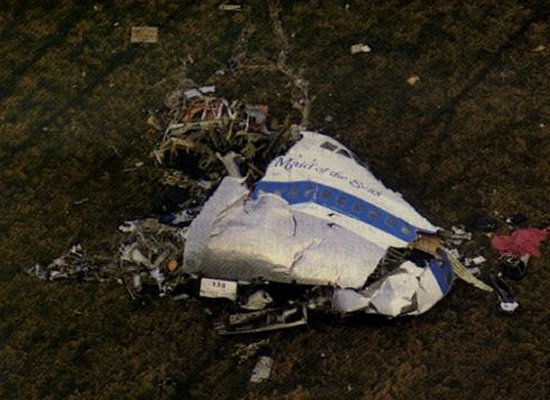
21 December 1988 - Pan American World Airways Flight 103
Pan Am 103 departed London bound for New York City when the Boeing 747
was destroyed over Lockerbie, Scotland. The plane was brought down by 340 to 450 grams of plastic explosives
hidden in a radio cassette player that was detonated in the forward cargo hold. The bombing killed 270 people
including 243 passengers, 16 crewmembers, and 11 victims on the ground. A three-year joint investigation by the
UK and US concluded two Libyan intelligence officers were behind the plot, and both men were finally turned over by
the Libyan government in 1999. One was convicted in 2001 while the second was acquitted, and Libya agreed to pay
compensation for the attack.
19 September 1989 - Union des Transports Aériens Flight 772
UTA 772 left Brazzaville, Congo, for N'Djamena, Chad aboard a Douglas
DC-10. The flight then departed for Paris carrying 170 people (156 passengers, 14 crew). About 45 minutes
after takeoff, the plane broke up over the Sahara Desert and crashed in Niger following the explosion of a bomb in
the forward cargo hold. The terror group Islamic Jihad claimed responsibility, and a rebel group called the Secret
Chadian Resistance was also suspected. However, explosive residue and part of a timing device were traced to
Libya. A Congolese terrorist confessed he had recruited a fellow dissident to unknowingly smuggle the bomb aboard
on behalf of Libyan secret service agents. Six Libyans were convicted, and the attack is believed to have been in
retaliation for France's support of Chad during conflicts between the two African nations. Libya agreed to pay
compensation to families of the victims in 2003.
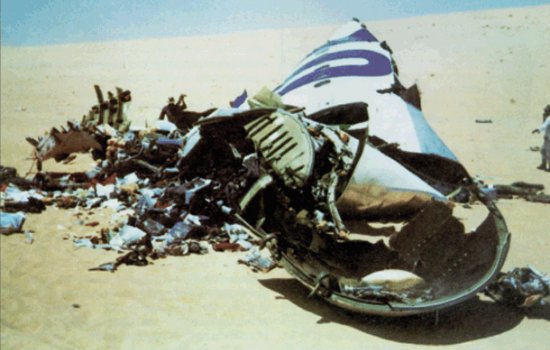
27 November 1989 - Avianca Airlines Flight 203
Avianca 203 was a Boeing 727 that departed Bogotá, Colombia, bound for
Cali. Just five minutes after takeoff, a bomb on the floor of the starboard side of the passenger cabin at seat
15F detonated. The blast ignited vapors in an empty fuel tank causing a massive explosion that ripped the plane
apart. The crash killed all 107 aboard (101 passengers, 6 crew) as well as 3 people on the ground. The Medellín
drug cartel claimed responsibility for the attack as an attempt to kill presidential candidate Cesare Gaviria.
Gaviria was not aboard but the group's chief assassin was convicted for the bombing.
18 March 1991 - Aeroflot
An Ilyushin 86 airliner was traveling from Moscow to Novokuznetsk with 360 passengers and crew. One of the
passengers was a psychiatric patient who had snuck an explosive aboard. After throwing the petrol bomb, a fire
ensued forcing an emergency landing at Sverdlovsk. No one aboard was harmed.
19 July 1994 - Alas Chiricanas Flight 00901
An EMBRAER EMB-110 left Colón, Panama, for Panama City when the plane exploded over the Santa Rita Mountains
killing 21 people (18 passengers, 3 crew). Investigators concluded a bomb, probably carried aboard by a suicide
bomber, caused the crash. Twelve of the passengers were Jewish, and an anti-Israeli group claimed responsibility
for the blast. The attack also occurred one day after the AMIA bombing in Buenos Aires that targeted Argentinian
Jews and eight days before a car bombing at the Israeli Embassy in London. All three attacks are believed to have
been orchestrated by Hezbollah, but no arrests have ever been made in connection to the Flight 00901 bombing.
11 December 1994 - Philippine Air Lines Flight 434
PAL434 was a multi-stage flight that first left Manila, Philippines, for Cebu aboard a
Boeing 747. After takeoff, a Middle Eastern passenger disappeared into
the lavatory where he assembled the components of a small bomb. The device was placed in the life vest under his
seat 26K before the man disembarked the aircraft. The second leg of the flight departed for Narita, Japan,
carrying 293 people (273 passengers, 20 crew) and a Japanese businessman named Haruki Ikegami occupied seat 26K.
The device detonated four hours after it was planted, killing Ikegami and injuring ten others. The blast blew a
hole through the floor to the cargo compartment below and also severed cables to the plane's control surfaces.
Though steering was crippled, the pilots made an emergency landing in Okinawa and no further lives were lost. Had
the bomb been placed two rows further back over the center fuel tank or turned to the side so its blast wave struck
the fuselage walls, the aircraft most likely would not have survived.
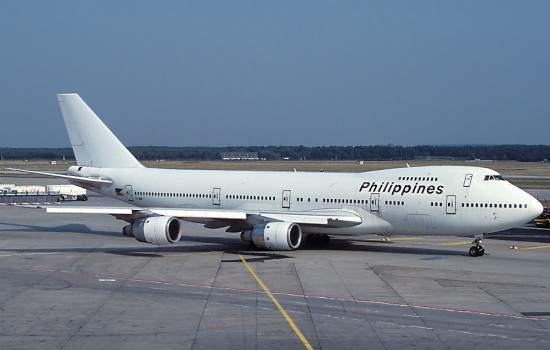
The man responsible for building and placing the bomb was Ramzi Yousef who had also masterminded the World Trade Center bombing in 1993. Yousef conducted the Philippine Air Lines bombing as a test of a much larger plot called Oplan Bojinka during which bombs ten times as powerful would have been smuggled aboard 11 or 12 transpacific flights bound for the United States. The attack was to occur on 21 and 22 January 1995 when five al-Qaeda operatives would sneak bombs aboard Northwest, Delta, and United Airlines flights in the same way Yousef had tested. Each bomb was to go off at about the same time causing the planes to fall into the Pacific Ocean or the South China Sea. It is estimated that some 4,000 people would have been killed if successful.
The elaborate plot also grew to include an assassination attempt on the Pope and hijacking airliners to crash into targets in the United States. An initial attack on CIA headquarters would later be followed by suicide crashes into the World Trade Center, the Pentagon, the Capitol Building, the White House, the Sears Tower in Chicago, and the Transamerica Tower in San Francisco. However, the ambitious plan quickly unraveled after a chemical fire arroused police suspicion. Within a matter of days, several of the conspirators were captured and confessed eventually leading to the arrest of Yousef himself. He has since been sentenced to life imprisonment for the plot plus another 240 years for his involvement in the World Trade Center bombing. Elements of Oplan Bojinka inspired both the September 11 attack and the August 2006 plot to bomb transatlantic flights that was foiled in the United Kingdom.
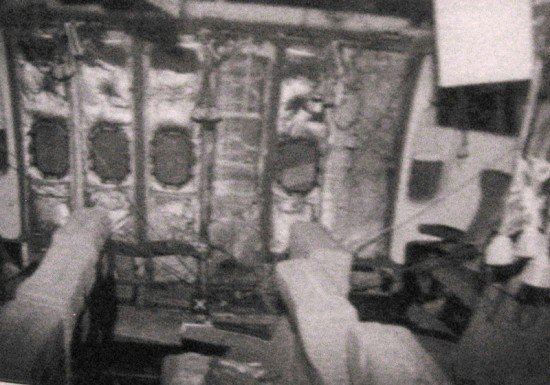
9 July 1997 - TAM Flight 283
A Fokker 100 operated by the Brazilian airline TAM was en route from Sao José dos Campos to Congonhas carrying
60 people (55 passengers, 5 crew). The plane was climbing through 7,875 ft (2,400 m) after takeoff when a bomb
exploded underneath seat 18D. The small device contained just seven ounces of explosive but the blast and
decompression blew a 6.5 ft (2 m) hole in the fuselage. The passenger in seat 18E was pulled from the plane and
died, but the remainder of the occupants survived after an emergency landing at São Paulo. A suicide attempt was
blamed as the motive.
22 December 2001 - American Airlines Flight 63
Shortly after the September 11 attacks, a radical Islamic terrorist named Richard Reid boarded a
Boeing 767 headed from Paris to Miami. As the plane flew across the
Atlantic Ocean, Reid attempted to detonate a bomb he had carried aboard in his shoes. His shoes were later found
to contain 100 grams of plasticized TATP and PETN explosives strong enough to blow a large hole in the fuselage
that most likely would have doomed the aircraft. A flight attendant first noticed Reid's actions and tried to stop
him, but a group of flight attendants and passengers was ultimately needed to subdue the suicide bomber. The
flight diverted to Boston where Reid was arrested, and he has since been sentenced to life in prison. A second
terrorist named Saajid Badat was also arrested and convicted as Reid's conspirator. Badat was to carry a similar
shoe bomb on a flight from Amsterdam to the US but backed out before the attempt.
7 May 2002 - China Northern Airlines Flight 6136
China Northern 6136 was a MD-82 carrying 112 (103 passengers, 9 crew)
from Beijing to Dalian. All appeared normal until the flight neared its destination and the pilot reported a fire
while requesting an emergency landing. Shortly thereafter, the plane crashed into the sea near Dalian with no
survivors. Investigators ultimately concluded a passenger named Zhang Pilin smuggled water bottles filled with
gasoline aboard and set them afire at his seat. The motive was most likely suicide for insurance since Pilin had
purchased seven policies shortly before the flight.
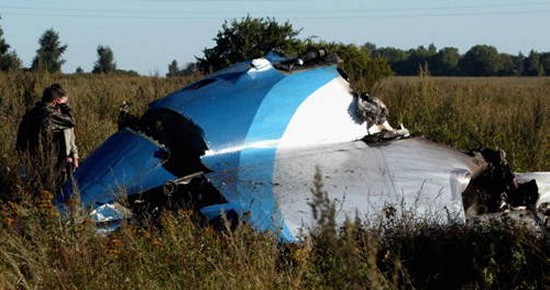
24 August 2004 - Volga-AviaExpress Flight 1303
A wave of terror attacks on Russia began with a pair of bombings aboard two airliners. The first was
Volga-AviaExpress 1303, a Tu-134 flying from Moscow to Volgograd. Contact with the plane was lost about 26
minutes after takeoff when witnesses on the ground reported seeing a large explosion. All 43 occupants (34
passengers, 9 crew) were killed. Later investigation found the crash was caused by a female suicide bomber named
Amanta Nagayeva who was from the separatist region of Chechnya.
24 August 2004 - Siberia Airlines Flight 1047
Minutes after the Volga-AviaExpress crash, a Siberia Airlines flight from Moscow to Sochi also disappeared. The
Tu-154 was carrying 46 people (38 passengers, 8 crew) and reportedly broadcast a hijack warning shortly before
crashing. There were no survivors. This attack was also made by a female Chechen suicide bomber named Satsita
Dzhebirkhanova. A group called Islambouli Brigade initially claimed responsibility for the two bombings, but
leading Chechen terrorist Shamil Basayev denied this and said he organized the attack. A week after the two
airline crashes, a bomb at the Moscow subway station killed 10 people. Shortly thereafter, the Beslan hostage
crisis in September resulted in 335 deaths.
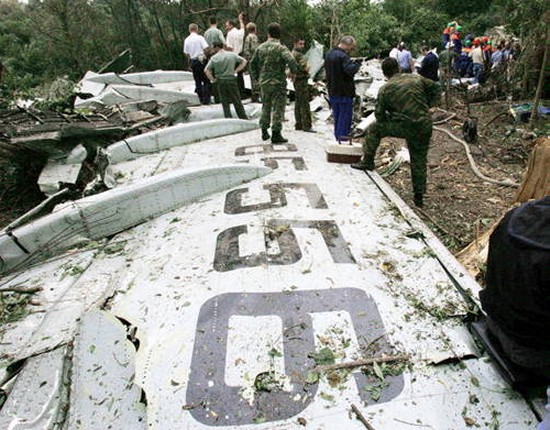
Summary
These cases graphically demonstrate the dangers explosives have posed to commercial aviation in over 70 years of recorded incidents. The full extent of these airline bombings can be appreciated when considering them in total. The 88 criminal acts detailed above destroyed 50 aircraft and damaged 32 more resulting in 2,790 deaths and 129 injuries. At least 33 of the bombings are known or strongly suspected to be terrorist attacks while 14 were a combination of suicide or murder attempts often coupled with insurance schemes. Four bombings were due to miscellaneous or accidental causes while the motive behind the remaining 37 is undetermined.
These statistics are summarized below by year. Bombings were worst during the 1970s and 1980s and at least one incident occurred every year from 1964 through 1989 with the lone exception of 1977. The single worst year was 1985 when five attacks resulted in 332 deaths, nearly all of these aboard Air India 182 alone. Airline bombings became less common through the 1990s and into the 21st century, but terrorism remains a grave threat to commercial air travel as shown by the hijackings and suicide attacks of 11 September 2001.

The UK terror arrests make it clear that bombings of commercial aircraft are likely to continue and will be even
deadlier given the increasing size of modern planes. In part two of this article, we will describe new
technologies developed to detect explosives before they make it aboard aircraft as well as methods of limiting
their damage when they do detonate.
- answer by Jeff Scott, 13 August 2006
Update!
Additional cases of airline bombings since this article was originally written are described below.
7 March 2008 - China Southern Airlines
A Boeing 757 operated by China Southern departed Urumqi in western
China. The flight carried a 19 year old female passenger who smuggled gasoline aboard by draining soda cans of
their contents and injecting them full of fuel with a syringe. The woman was a frequent traveler who exploited
her familiarity with airport personnel to bypass rules banning liquids on planes. She also used fragrances to
disguise the distinctive smell of the gasoline. About 40 minutes after takeoff, the woman took the cans into a
bathroom near the wing fuel tanks and tried to start a fire. She was discovered by members of the flight crew
who prevented her attempt and made an emergency landing in Lanzhou with no injuries. The woman was reportedly a
member of China's Uighur Muslim minority and the motivation for the attack is believed to be jihadist terrorism.
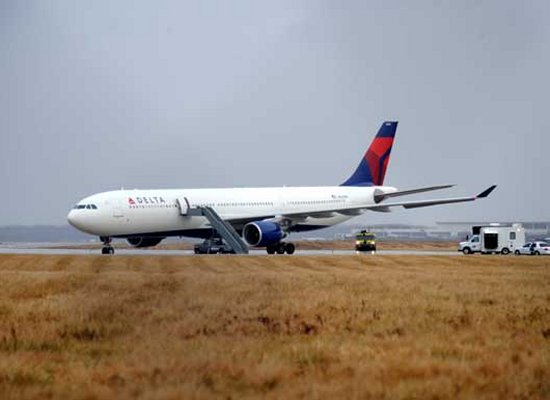
25 December 2009 - Northwest Airlines Flight 253
Northwest 253 departed Amsterdam for Detroit, Michigan, aboard an Airbus
A330 carrying 289 people (278 passengers, 11 crew). Shortly before landing, a young Nigerian passenger named
Umar Farouk Abdulmutallab attempted to set off 80 grams of PETN and TATP plastic explosives he had smuggled aboard
in his underwear. The bomb malfunctioned creating only a small fire and popping noises instead of detonating.
Dutch passenger Jasper Schuringa tackled and subdued Abdulmutallab while other passengers and flight attendants put
out the fire. The pilots made an emergency landing at Detroit where the bomber was arrested. Aside from
Abdulmutallab who suffered burns to his legs, Schuringa and another passenger were injured. Investigation
indicated Abdulmutallab was recruited, trained, and funded by the Yemeni group al-Qaeda in the Arabian Peninsula
hoping to perpetrate a terrorist attack over a US city.
21 March 2010 - Kingfisher Airlines Flight IT-4731
After all 27 passengers had disembarked from a Kingfisher ATR 72 arriving at the Indian city of Thiruvananthapuram
from Bangalore, a crude bomb was found in the cargo section. The plane was moved to a remote part of the airport
where the device was inspected by a bomb squad. The explosive consisted of a 15 gram firecracker designed to be
lit manually. The crime was traced to a baggage handler named Rajasekharan Nair who first reported discovering the
bomb. He had previously worked for the Indian security force and is believed to have been trying to embarrass
former coworkers he was angry with.
October 2010 - Cargo Bombing Attempt
On 29 October 2010, officials discovered two packages addressed to Jewish organizations in Chicago that contained
explosive material. The sophisticated bombs contained approximately one pound of the explosive PETN and were found
aboard cargo planes, although each had also been carried on passenger flights before their discovery. The first
was found on a UPS plane in the United Kingdom while the second was discovered aboard a FedEx aircraft at Dubai.
Each bomb was packaged within a printer toner cartridge and "the explosives discovered were of a sophisticated
nature whereby they could not be detected by X-ray screening or trained sniffer dogs." The devices were to be
triggered by cell phone alarms set to detonate while the planes were estimated to be over the Atlantic Ocean.
Investigators believe the bombs were intended to destroy planes in flight, although it is unclear whether the
perpetrators could have known whether they would be carried aboard passenger or freight aircraft. Both packages
originated in Yemen and the organization al-Qaeda in the Arabian Peninsula is believed responsible.
Read More Articles:


|
Aircraft | Design | Ask Us | Shop | Search |

|
|
| About Us | Contact Us | Copyright © 1997-2023 | |||
|
|
|||